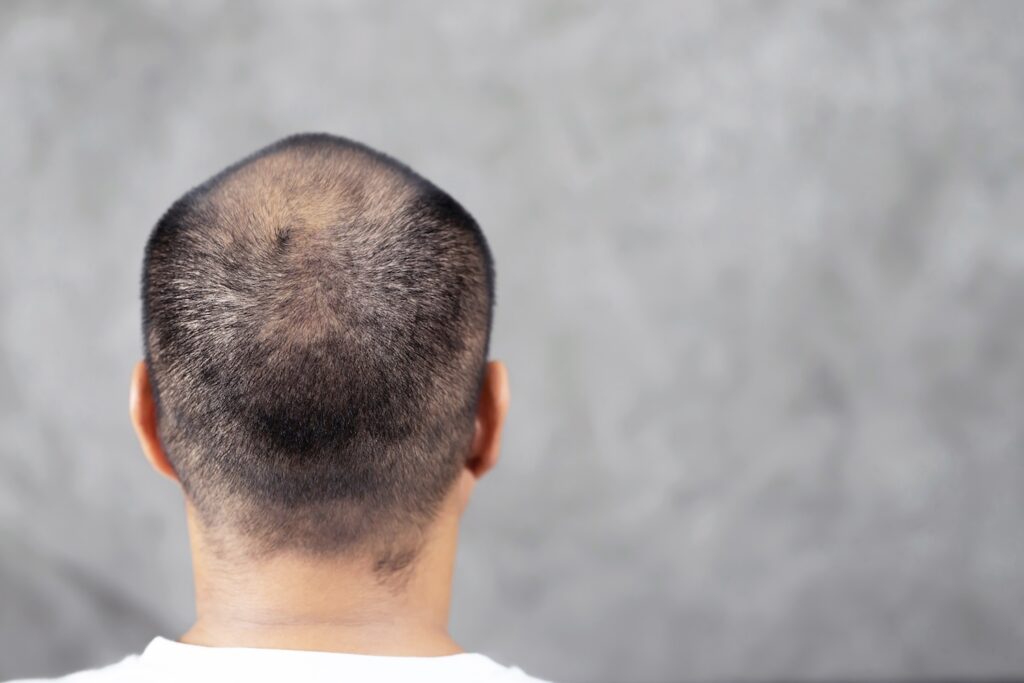
Have you noticed more hair on your pillow or in the shower drain lately? You’re not alone. Male pattern baldness is a common condition that can start as early as your 20s, causing thinning hair and receding hairlines. It’s estimated that there are over 15.4 million people in the UK who are currently experiencing hair loss.
But what exactly causes this, and more importantly, what can you do about it? One potential treatment for hair loss is finasteride, a prescription medicine that has shown promising results in slowing hair loss and even increasing hair regrowth in men.
The number of men with androgenetic alopecia (male pattern baldness) increases significantly with age, with 30% of white men experiencing hair loss by age 30, 50% by age 50, and a staggering 80% by age 70. These statistics highlight just how common this condition is, impacting the lives of men across all age groups.
Male pattern baldness is usually caused by a mix of genetics and hormones. It involves a higher sensitivity to a hormone called dihydrotestosterone (DHT), which comes from testosterone. This causes the hair to thin until it stops growing completely.
While male pattern baldness is a natural part of ageing for many men, it can really impact self-esteem and confidence. The good news is that effective medications are available to treat hair loss, and one of the most popular and well-studied options is finasteride.
Finasteride is a popular treatment for male pattern baldness, which is taken as a daily tablet. It is especially effective if you have recently started losing hair, or if you are under the age of 60.
It was originally developed to treat enlarged prostates, but researchers discovered its potential for combating hair loss. Studies have shown great results, so now finasteride is a top choice for men looking for hair regrowth medication. In the last 12 months, OpenPrescribing shows that finasteride has been prescribed over 4 million times in the UK, making it a leading hair loss treatment.
Finasteride works by targeting DHT production. DHT causes hair follicles to shrink, leading to hair thinning in men who are genetically prone to it.
Finasteride lowers the amount of DHT in the scalp by blocking an enzyme that converts testosterone to DHT. With less DHT, hair loss slows down, and new hair can even grow back. This helps keep hair follicles healthier and prevents further hair loss.
To get the best results, you need to keep taking finasteride regularly. If you stop, DHT levels will go up again, and hair loss may continue.
Finasteride has been proven to be effective for many men. Studies show that after two years, 83% of men taking finasteride had no further hair loss, while 72% of men who didn’t take it continued to lose hair. This shows that finasteride can stop hair loss for most men who use it regularly.
It’s important to note that finasteride doesn’t work overnight and can work quicker for some patterns of hair loss than others. Most men start to see results between 3 and 12 months after they start taking it every day, but for some men, it can take a year to see any real improvements. The key is to be patient and take it regularly for it to keep working.
Long-term studies have found that 99% of men taking finasteride retain their hair for many years if they continue to take it regularly. However, these results aren’t permanent so if you stop taking it, you may lose any hair you’ve kept or regrown within 6-12 months.
Another popular treatment option for hair loss is minoxidil, which is the active ingredient in Regaine. If you have tried minoxidil (either as a tablet or a topical solution) but haven’t had much success, you might find finasteride works better. Studies have shown that finasteride usually produces better results than minoxidil, especially for hair loss on the top of the head.
Some men find that using both finasteride and minoxidil together works even better for them. These two medicines work in different ways, so using both can be a good way to fight hair loss from different angles.
To get the best results, it’s important to use finasteride regularly. To maintain a stable level in your body, make sure you take your dose at the same time daily, regardless of meals.
Hair loss can negatively impact your self-esteem, and you may be looking for a quick fix. Finasteride has excellent success rates, but unfortunately, it does take time. Most men begin to see changes after 3-4 months of daily use, but the full effects can take a year or more. Once you start the treatment, you might find that monitoring your progress by taking photos of your hair every few months can help you notice changes that you might miss by looking in the mirror daily.
To give finasteride the best chance of working, you should try to make healthy choices that will benefit your hair growth. Aim to eat a balanced diet rich in hair-friendly vitamins such as vitamin D, reduce stress, and avoid harsh hair treatments. It’s also a good idea to avoid wearing tight hats or hairbands frequently as they can cause hair breakage.
Some men find that combining finasteride with other hair loss treatments, like minoxidil, works better. However, consult your pharmacist or GP first to ensure it’s safe for you.
If you’re worried about hair loss, it’s time to take action. At Click2Pharmacy, we know how losing your hair can impact your confidence. Our hair loss clinic can help you find the right hair loss treatment. Simply complete our easy online consultation and choose your treatment for our pharmacists to review. Once approved by our qualified team, your treatment will be discreetly delivered to your door.
Don’t let hair loss stop you from feeling like yourself – visit our online clinic today and take the first step towards a fuller head of hair.
While finasteride is generally well-tolerated, it’s important to be aware of potential side effects. A small percentage of men may experience decreased libido, erectile dysfunction, or other sexual side effects. These side effects are typically mild and often resolve over time or after discontinuing the medication.
Finasteride is commonly taken as a daily pill, however, there are developments into a topical version you can apply directly to your scalp. This topical finasteride is still being studied, but initial research suggests it could be just as effective as oral finasteride. A key benefit of this cream is that it may lead to fewer side effects since less of the medication enters the bloodstream.
Finasteride can help patients with male-pattern hair loss regrow hair, especially if the hair loss has happened recently. It blocks the hormone that causes hair loss, which can lead to an increase in hair growth and prevent further hair shedding. However, the results can vary from person to person.
Finasteride works best if you start using it early in the hair loss process, particularly for patients with male pattern hair loss. If you’re already bald, finasteride is less likely to help halt hair loss or restore hair. In these cases, other treatments like hair transplants might be better options.







